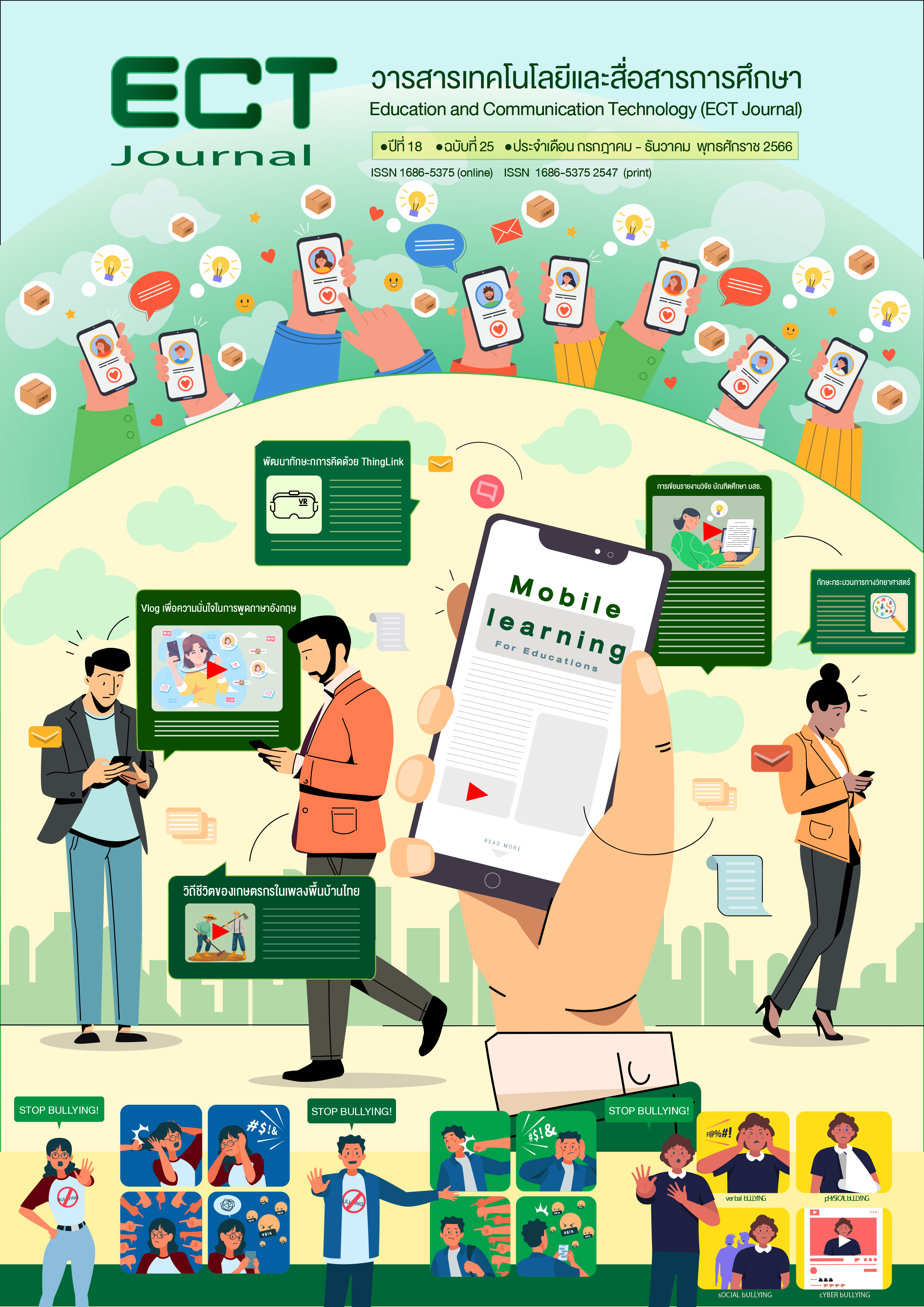Enhancing Higher-Order Thinking Skills Through Thinglink Interactive Visual Learning Technology
Keywords:
Learning Technology, Interactive Visual, Higher-Order Thinking Skills, ThingLinkAbstract
The purpose of this study was to present ideas about enhancing higher-order thinking skills via ThingLink interactive visual learning technology through the connectivism learning theory and digital media design in a variety of methods. this article describes the concept of interactive visual learning such as the types of interactive visual learning, the format of tags to develop digital media design, the concept of teaching strategy methodology, and the organizing of a digital learning environment according to constructivism. Also, this article has collected research results and the future trends in interactive visual learning technology to encourage teachers to manage online education effectively and suitable for learners in the digital age.
References
ใจทิพย์ ณ สงขลา. (2557). มหคอร์สแวร์แบบเปิด-มูค (MOOC--Massive Open Online Courseware) คอนเน็คติวิสม์ในศตวรรษที่ 21: ประกอบการเชิงสังคมในบทบาทมหาวิทยาลัยเพื่อความรับผิดชอบต่อสังคม. วารสารครุศาสตร์ จุฬาลงกรณ์มหาวิทยาลัย, 42(1), 224-240.
บรรจง อมรชีวัน. (2556). Thinking school สอนให้คิด (พิมพ์ครั้งที่ 1). ห้างหุ้นส่วนจำกัดภาพพิมพ์.
ศยามน อินสะอาด. (2559). การออกแบบบทเรียนอีเลิร์นนิงเพื่อพัฒนาทักษะการคิดขั้นสูงระดับอุดมศึกษา. Veridian E-Journal, Silpakorn University ฉบับภาษาไทย สาขามนุษยศาสตร์ สังคมศาสตร์ และศิลปะ, 9(3), 906-922. https://he02.tci-thaijo.org/index.php/Veridian-E-Journal/article/view/74209
ศิริลักษณ์ บุญมาพันธ์, ศยามน อินสะอาด, และสุพจน์ อิงอาจ. (2564). การพัฒนาบทเรียนไมโครเลิร์นนิงบนเครือข่ายสังคมออนไลน์ตามแนวคอนสตรัคติวิสต์เพื่อส่งเสริมการคิดวิเคราะห์ สำหรับนักเรียนชั้นมัธยมศึกษาปีที่ 6. วารสารเทคโนโลยีและสื่อสารการศึกษา, 16(21), 65-78. https://so01.tci-thaijo.org/index.php/ectstou/article/view/249675
Inayah, A. F., Murni, R., & Dwi, T. R. (2022). The effect of STEM-ThingLink learning design on students' conceptual understanding of nutrition. BIOSFER: Jurnal Tadris Biologi, 13(1), 111-125. http://ejournal.radenintan.ac.id/index.php/biosfer/article/view/11920
Inozemtseva, K., Kirsanova, G., Troufanova, N., & Semenova, Y. (2018). Using ThingLink digital posters in teaching ESP to business and economics students: A case study of Bauman Moscow State Technical University. European Journal of Contemporary Education, 7(3), 498-510. https://doi.org/10.21125/iceri.2018.1780
Jeffery, A., Rogers, S., Pringle, J. K., Zholobenko, V. L., Jeffery, K., Wisniewski, K., Haxton, K., & Emley, D. (2022). Thinglink and the laboratory: Interactive simulations of analytical instrumentation for HE science curricula. Journal of Chemical Education, 99(4), 1666-1672. https://doi.org/10.1021/acs.jchemed.1c01067
Roslan, N., Najhah, A., & Sahrir, M. S. (2020). The effectiveness of ThingLink in teaching new vocabulary to non-native beginners of the Arabic language. International Journal of Education and Social Sciences, 8(1), 59-65. https://doi.org/10.31436/ijes.v8i1.274
Ulla-Maaria, K. (2020, April 28). New tools for the flipped school: Interactive visual media in remote learning. ThingLink. https://sandbox.thinglink.com/articles/new-tools-for-the-flipped-school-interactive-visual-media-in-remote-learning
UNESCO. (2021). ThingLink visual learning technology: An immersive learning tool for accessible quality education. http://unesdoc.unesco.org
Yulianti, M. (2022). Improving self-regulation learning through online tutorial services STAD assisted media Thinglink mode. Ideguru: Journal Karya Ilmiah Guru, 7(1), 71-78. https://doi.org/10.51169/ideguru.v7i1.340
Downloads
Published
How to Cite
Issue
Section
License
Copyright (c) 2023 มหาวิทยาลัยสุโขทัยธรรมาธิราช

This work is licensed under a Creative Commons Attribution-NonCommercial-NoDerivatives 4.0 International License.
1. ทรรศนะและข้อคิดเห็นใด ๆ ที่ปรากฏอยู่ในวารสาร ECT Education and Communication Technology Journal เป็นของผู้เขียนโดยเฉพาะ สำนักเทคโนโลยีการศึกษา มหาวิทยาลัยสุโขทัยธรรมาธิราช และกองบรรณาธิการไม่จำเป็นต้องเห็นพ้องด้วย
2. กองบรรณาธิการของสงวนลิขสิทธิ์ในการบรรณาธิการข้อเขียนทุกชิ้น เพื่อความเหมาะสมในการจัดพิมพ์เผยแพร่






